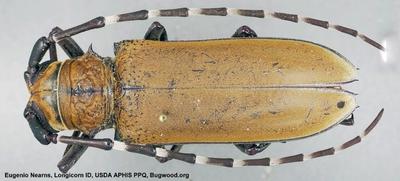Apple Stem Borer
Apriona cinerea
Insect
In a Nutshell
- Resin is emitted from holes on the bark.
- Accumulation of a large amount of ejected frass (insect droppings) at the base of infected trees.
- Wilted leaves.
- Tree dieback.
Can also be found in
Symptoms
The adult beetle feeds on the bark of shoots. On an infected stem, the scar from egg-laying (oviposition) is very visible. Usually, one crescent-shaped scar is present on each branch of bigger trees. Larval activity is recognized by the presence of galleries (zigzag burrows) under the bark, and later, tunnels in the wood. In young plants, resin bleeds from oviposition holes and larval tunnels in the bark may be seen and also tunnels into the roots are observed. In the early stages of larval growth, frass expulsion holes are close to each other, but as they mature and grow in size, larger frass expulsion holes are formed which are further apart.
Recommendations

Organic Control
Use parasitic nematodes such as Stienernema Pravassos and Heterorhabditis spp., and natural enemies such as Neoplectana nematodes and Elatrid beetle. Inject Beauvaria bassiana into larval holes. Treat wood packaging material according to ISPM 15.

Chemical Control
Always consider an integrated approach with preventive measures together with biological treatments, if available. Inject 10 ml of Monocrotophos 36 WSC and plug with wet clay to kill the grub.
What caused it?
Damage is caused by the grub and adult stem borer, however, the grub is more destructive. The grub is light yellow with a dark brown flat head, while the adult is light grey with numerous black tubercles at the base. Eggs are laid on either branches or the main stem under the bark, in oviposition slits, previously chewed out by the female. After 5-7 days the larvae hatch and bore downward in the trunk, creating tunnels to the surface and holes at regular intervals through which droppings (frass) are ejected. The larva is a creamy white legless grub, elongated and cylindrical in shape. The larva of A. cinerea are easier to detect compared with other borers, due to the presence of regular frass expulsion holes.
Preventive Measures
- Keep the orchard healthy, following good agricultural practices.
- Monitor and prune branches containing grubs before they enter the tree trunk.
- Remove other host trees such as mulberry or paper mulberry on which maturation and feeding occur.
- Manually catch and kill adults.
- Kill the larvae by inserting a flexible wire inside the hole, plug the hole with a cotton wick soaked in petrol and seal it with mud.
- Use cultural practices such as sanitation felling (destruction of damaged and infected plants or pruning).
- Also, use trap trees.
- New plantations should not be established near infested stands.



